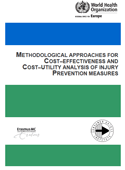Methodological approaches for cost–effectiveness and cost–utility analysis of injury prevention measures

Download
Economic evaluation plays an increasing role in prioritizing the implementation of the treatment and prevention of both unintentional and intentional injuries. Policy-makers and decision-makers generally need information about the effectiveness of an intervention in relation to its costs to assess whether an intervention provides good value for money. A review of the literature has shown that few methodologically robust and comparable studies have been undertaken in the field of injury prevention.
This document provides step-wise guidance on the use of standardized methods to conduct cost-effectiveness and cost-utility analyses on injury prevention interventions, thereby contributing to a larger body of such evidence. The added value of this guide is that it links general guidelines on economic evaluation studies to a step- by-step guide for performing economic evaluation studies of injury prevention interventions. It focuses on the specifics of health outcomes and costs in injury prevention. It is hoped that the framework provided in this document will assist public health experts, researchers and policy-makers who are interested in estimating the cost–effectiveness and cost–utility of injury prevention programmes. The use of this document will hopefully contribute to increasing the evidence base of economic evaluations of injury prevention programmes in the European Region.



